Abstract
Since the complete cDNA for the gene that causes X-linked recessive Duchenne/Becker muscular dystrophy (DMD/BMD) when mutated or deleted has recently been cloned and made generally available, DNA-based diagnostic studies of affected males and their families have entered into a new era. This communication sets forth the standard patterns of restriction fragments that are detected when normal human DNA cleaved with either HindIII or BglII is hybridized with seven contiguous segments comprising the entire 14-kb cDNA. Collectively, the more than 60 restriction fragments allow visualization of approximately 350 (HindIII) to 400 (BglII) kbp. This corresponds to the exon-containing one-fifth of the total genomic length of this gene, including the 3' untranslated region. Twelve two-allele restriction-site polymorphisms that span the entire length of the gene were detected with the cDNA probes and allele frequencies determined. A diagnostic approach is proposed that starts with deletion screening of DNA from male probands, includes carrier detection based on relative fragment intensities, and extends to RFLP detection using the same autoradiographs prepared for deletion screening. Our results on deletion analysis of 32 DMD/BMD families are presented in an accompanying paper.
Full text
PDF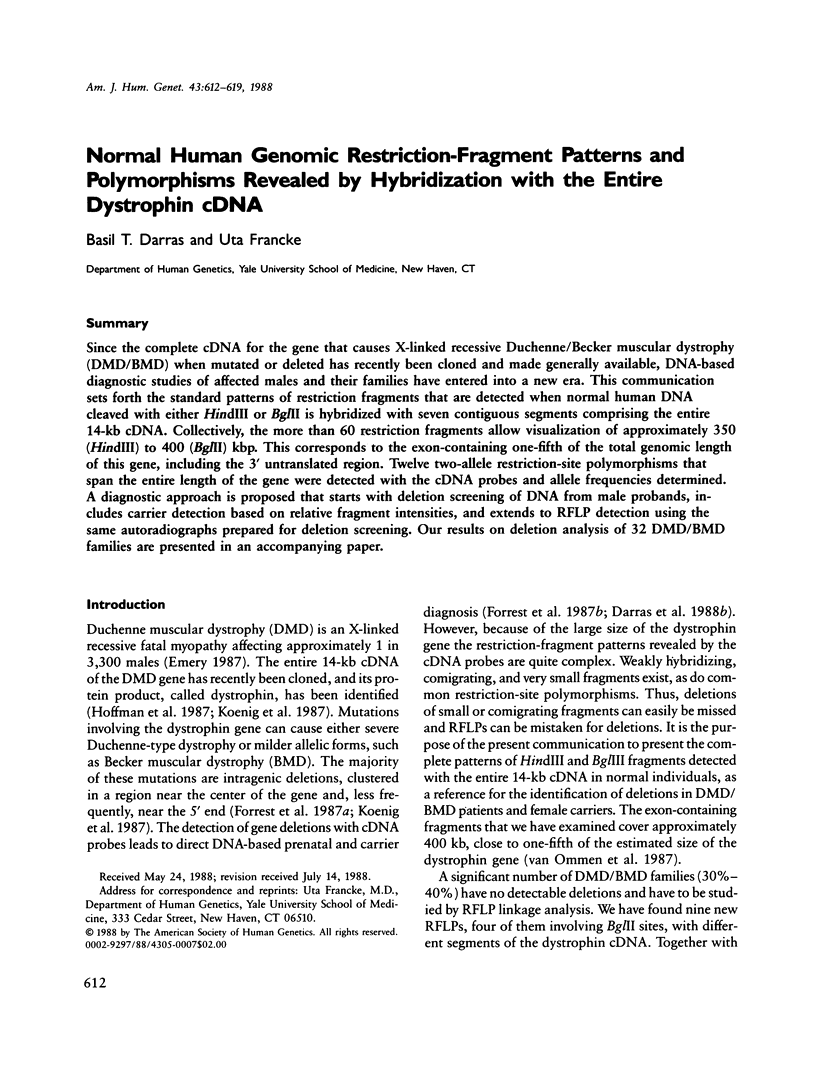
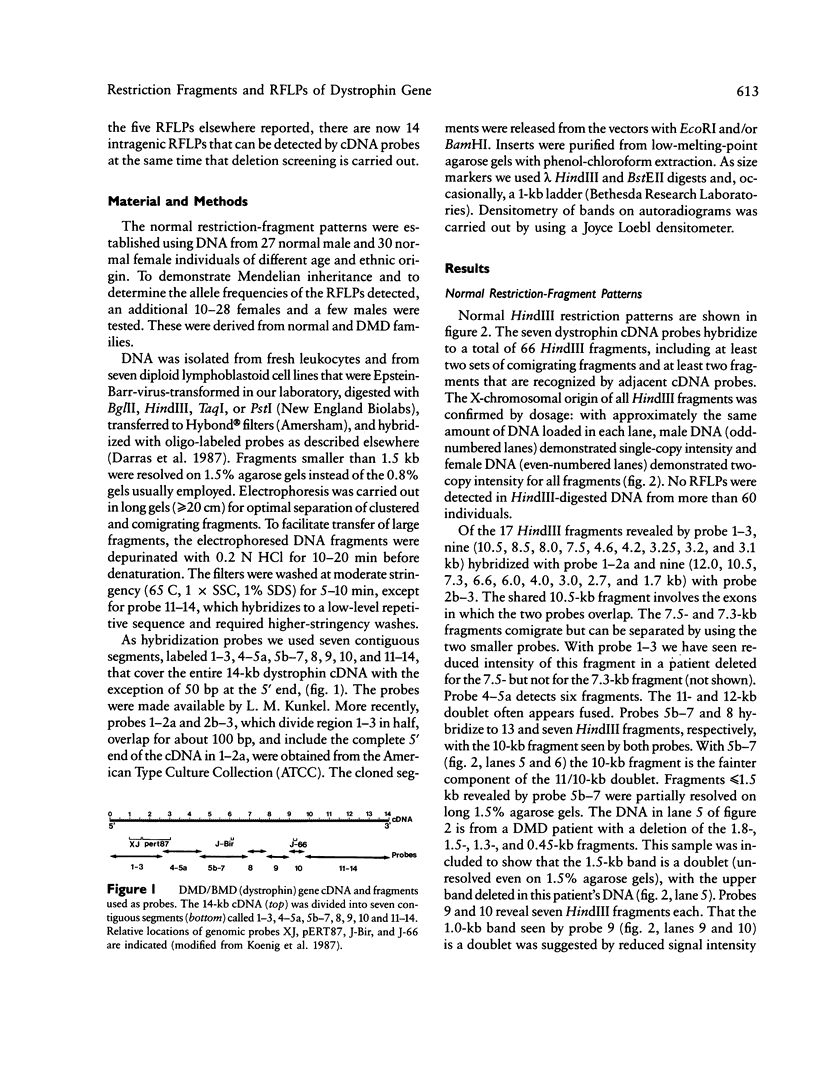
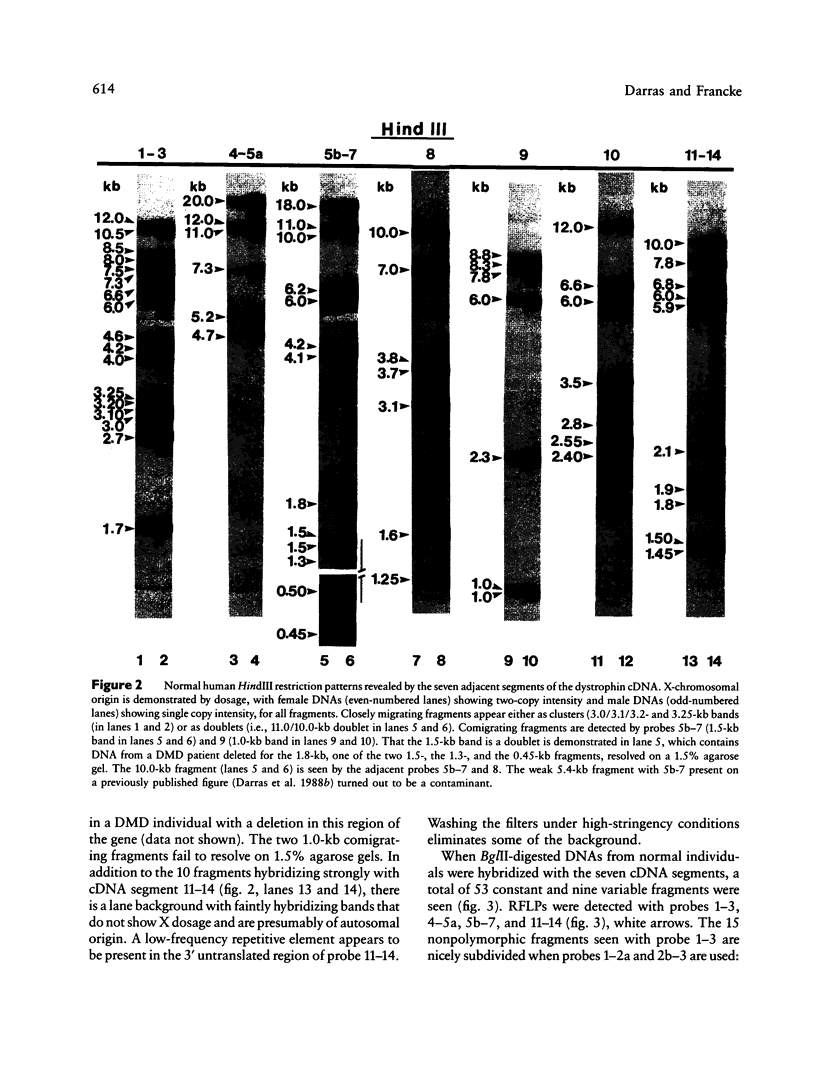
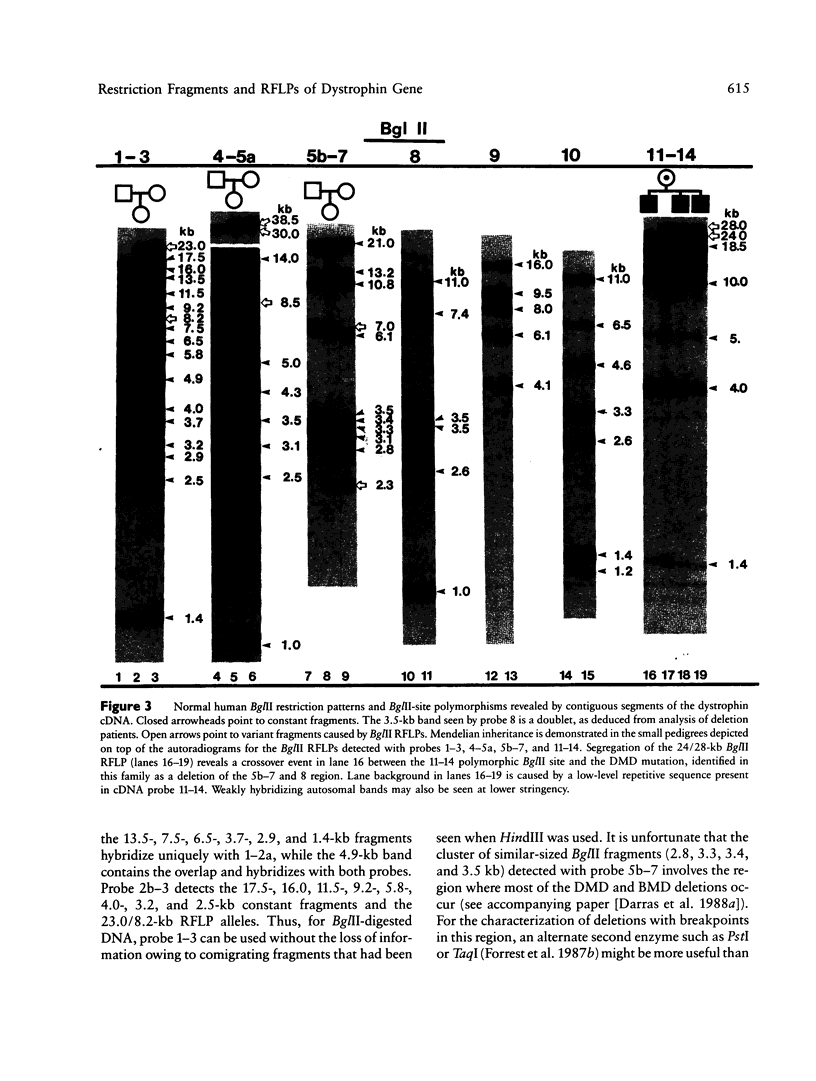
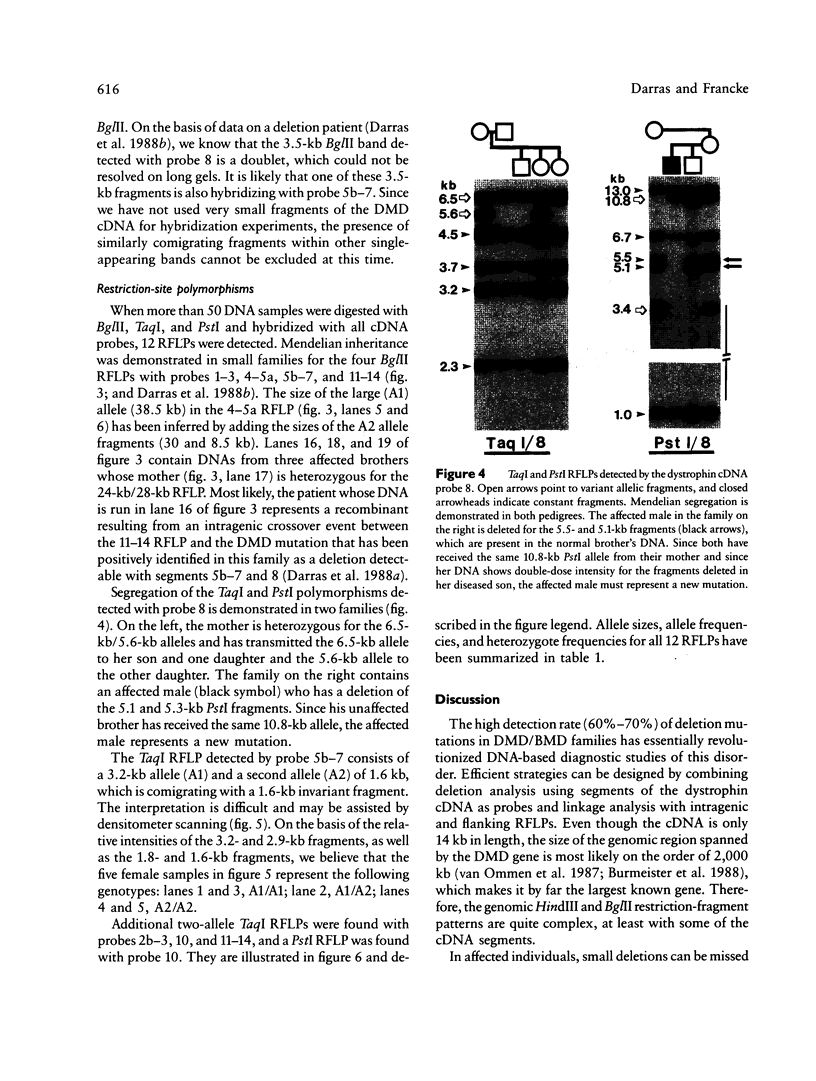


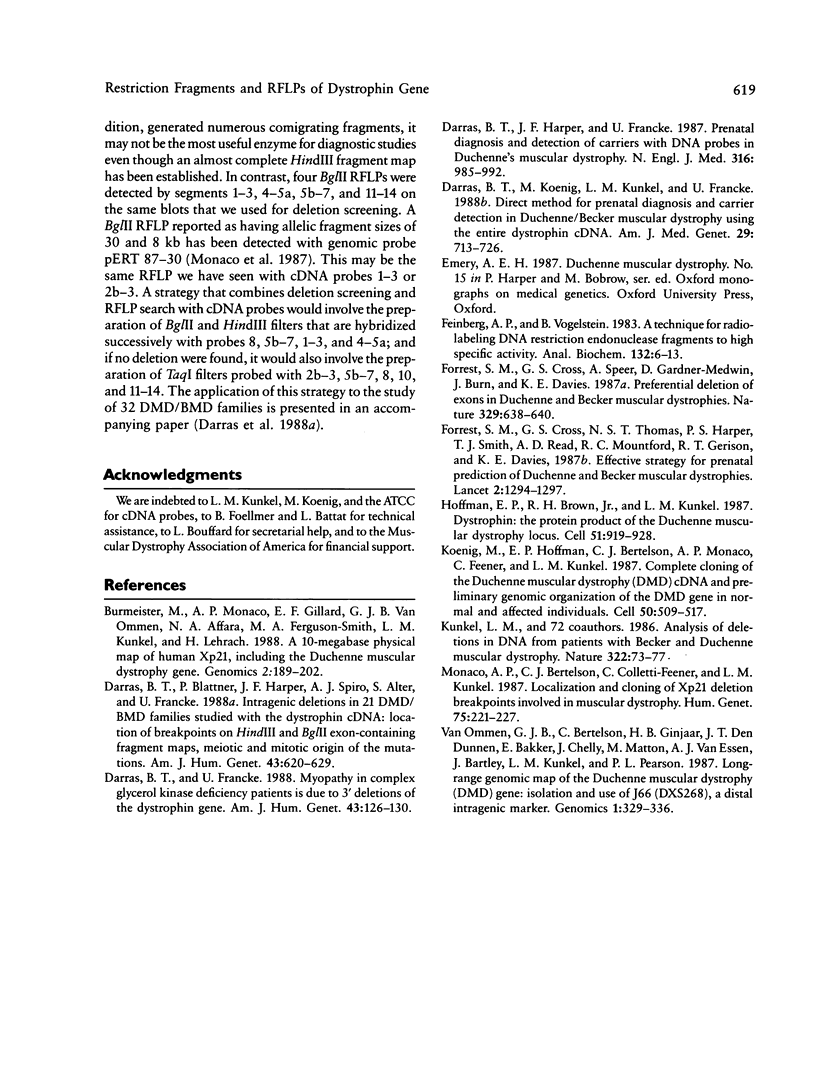
Images in this article
Selected References
These references are in PubMed. This may not be the complete list of references from this article.
- Burmeister M., Monaco A. P., Gillard E. F., van Ommen G. J., Affara N. A., Ferguson-Smith M. A., Kunkel L. M., Lehrach H. A 10-megabase physical map of human Xp21, including the Duchenne muscular dystrophy gene. Genomics. 1988 Apr;2(3):189–202. doi: 10.1016/0888-7543(88)90002-x. [DOI] [PubMed] [Google Scholar]
- Darras B. T., Blattner P., Harper J. F., Spiro A. J., Alter S., Francke U. Intragenic deletions in 21 Duchenne muscular dystrophy (DMD)/Becker muscular dystrophy (BMD) families studied with the dystrophin cDNA: location of breakpoints on HindIII and BglII exon-containing fragment maps, meiotic and mitotic origin of the mutations. Am J Hum Genet. 1988 Nov;43(5):620–629. [PMC free article] [PubMed] [Google Scholar]
- Darras B. T., Francke U. Myopathy in complex glycerol kinase deficiency patients is due to 3' deletions of the dystrophin gene. Am J Hum Genet. 1988 Aug;43(2):126–130. [PMC free article] [PubMed] [Google Scholar]
- Darras B. T., Harper J. F., Francke U. Prenatal diagnosis and detection of carriers with DNA probes in Duchenne's muscular dystrophy. N Engl J Med. 1987 Apr 16;316(16):985–992. doi: 10.1056/NEJM198704163161604. [DOI] [PubMed] [Google Scholar]
- Darras B. T., Koenig M., Kunkel L. M., Francke U. Direct method for prenatal diagnosis and carrier detection in Duchenne/Becker muscular dystrophy using the entire dystrophin cDNA. Am J Med Genet. 1988 Mar;29(3):713–726. doi: 10.1002/ajmg.1320290341. [DOI] [PubMed] [Google Scholar]
- Feinberg A. P., Vogelstein B. A technique for radiolabeling DNA restriction endonuclease fragments to high specific activity. Anal Biochem. 1983 Jul 1;132(1):6–13. doi: 10.1016/0003-2697(83)90418-9. [DOI] [PubMed] [Google Scholar]
- Forrest S. M., Cross G. S., Speer A., Gardner-Medwin D., Burn J., Davies K. E. Preferential deletion of exons in Duchenne and Becker muscular dystrophies. Nature. 1987 Oct 15;329(6140):638–640. doi: 10.1038/329638a0. [DOI] [PubMed] [Google Scholar]
- Forrest S. M., Smith T. J., Cross G. S., Read A. P., Thomas N. S., Mountford R. C., Harper P. S., Geirsson R. T., Davies K. E. Effective strategy for prenatal prediction of Duchenne and Becker muscular dystrophy. Lancet. 1987 Dec 5;2(8571):1294–1297. doi: 10.1016/s0140-6736(87)91192-5. [DOI] [PubMed] [Google Scholar]
- Hoffman E. P., Brown R. H., Jr, Kunkel L. M. Dystrophin: the protein product of the Duchenne muscular dystrophy locus. Cell. 1987 Dec 24;51(6):919–928. doi: 10.1016/0092-8674(87)90579-4. [DOI] [PubMed] [Google Scholar]
- Koenig M., Hoffman E. P., Bertelson C. J., Monaco A. P., Feener C., Kunkel L. M. Complete cloning of the Duchenne muscular dystrophy (DMD) cDNA and preliminary genomic organization of the DMD gene in normal and affected individuals. Cell. 1987 Jul 31;50(3):509–517. doi: 10.1016/0092-8674(87)90504-6. [DOI] [PubMed] [Google Scholar]
- Kunkel L. M., Hejtmancik J. F., Caskey C. T., Speer A., Monaco A. P., Middlesworth W., Colletti C. A., Bertelson C., Müller U., Bresnan M. Analysis of deletions in DNA from patients with Becker and Duchenne muscular dystrophy. Nature. 1986 Jul 3;322(6074):73–77. doi: 10.1038/322073a0. [DOI] [PubMed] [Google Scholar]
- Monaco A. P., Bertelson C. J., Colletti-Feener C., Kunkel L. M. Localization and cloning of Xp21 deletion breakpoints involved in muscular dystrophy. Hum Genet. 1987 Mar;75(3):221–227. doi: 10.1007/BF00281063. [DOI] [PubMed] [Google Scholar]
- van Ommen G. J., Bertelson C., Ginjaar H. B., den Dunnen J. T., Bakker E., Chelly J., Matton M., van Essen A. J., Bartley J., Kunkel L. M. Long-range genomic map of the Duchenne muscular dystrophy (DMD) gene: isolation and use of J66 (DXS268), a distal intragenic marker. Genomics. 1987 Dec;1(4):329–336. doi: 10.1016/0888-7543(87)90032-2. [DOI] [PubMed] [Google Scholar]







